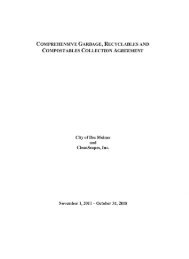CITY OF DES MOINES SHORELINE MASTER PROGRAM
CITY OF DES MOINES SHORELINE MASTER PROGRAM
CITY OF DES MOINES SHORELINE MASTER PROGRAM
You also want an ePaper? Increase the reach of your titles
YUMPU automatically turns print PDFs into web optimized ePapers that Google loves.
Des Moines Shoreline Inventory and Characterization<br />
large landslide complex, mapped as an Unstable Old Slide on the Coastal Zone Atlas, that may<br />
have failed during one or more large earthquakes (AGRA, 1997, and Shannon & Wilson, 1998).<br />
This large landslide complex periodically reactivates, most recently in January 1997.<br />
Where not coastal beach, most of segments G and F are mapped as urban land. Smaller areas of<br />
urban land are also designated in segment A, along Des Moines Creek. The mouth of Massey<br />
Creek in segments B and C is mapped as Pilchuck loamy fine sand, which forms on alluvial<br />
terraces. Indianola loamy fine sand on slopes of 4 to 15 percent generally forms on deposits of<br />
outwash sand. These soils were mapped in very small areas in segments A, B, and G.<br />
Seismic Hazard Areas<br />
Seismic hazard areas are defined in Chapter 18.04.557 of the Des Moines Municipal Code<br />
(DMMC) as those areas subject to severe risk of earthquake damage as a result of seismically<br />
induced settlement or soil liquefaction. These conditions occur in areas underlain by<br />
cohesionless soils of low density, usually in association with a shallow groundwater table. No<br />
seismic hazard areas are identified within the shoreline jurisdiction in the King County Sensitive<br />
Areas Map Folio (King County, 1990). However, Washington Department of Natural Resources<br />
maps areas of liquefaction susceptibility in all segments except Segment F, often associated with<br />
the lower reaches and stream mouths of Des Moines, Massey, McSorley, Woodmont, and Cold<br />
Creeks (Figure 12).<br />
Landslide Hazard Areas<br />
Landslide hazard areas are defined in Chapter 18.04.363 of DMMC as those areas of the city<br />
subject to a severe risk of landslide. They are defined as any area with a combination of slopes<br />
greater than 15 percent, impermeable soils, and springs or groundwater seepage; any area<br />
showing movement during the last 10,000 years; or any potentially unstable area as a result of<br />
stream incision.<br />
Landslide hazard area information for the City’s shoreline jurisdiction was taken from the King<br />
County Sensitive Areas Map Folio (King County, 1990) and is shown on Figure 10. Designated<br />
landslide hazard areas include the shore bluff in segment D, segment E excluding the flatter<br />
slopes at the southern end of the segment in the community of Redondo, and the steep slopes on<br />
either side of Cold Creek in segment G. The extent of designated landslide hazard areas may not<br />
correspond exactly with the mapped extent of mass wasting deposits or with the slope stability<br />
and landslide area designations indicated on the Coastal Zone Atlas (Figure 11).<br />
Erosion Hazard Areas<br />
Erosion hazard areas are defined in Chapter 18.04.262 of DMMC as those areas underlain by<br />
soils identified by the U.S. Department of Agriculture Soil Conservation Service as having<br />
“severe” or “very severe” erosion hazard potential. Such areas designated on King County GIS<br />
maps (King County, 2002) include all coastal bluffs and steep slopes within the jurisdiction,<br />
which includes all shoreline segments. These areas are shown on Figure 12.<br />
Page 24 March 2005



